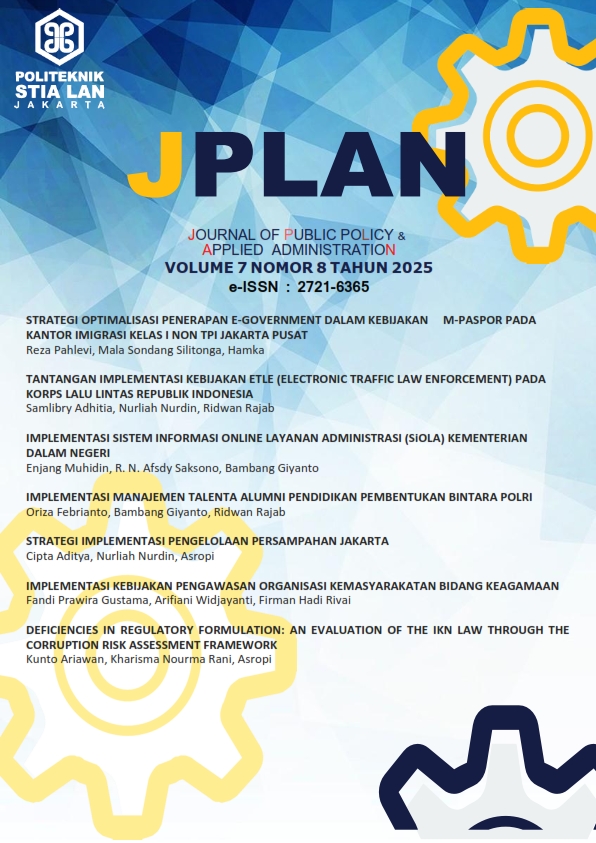Main Article Content
Abstract
Keywords: IKN, Corruption Risk Assessment, Law Formulation
Article Details
References
- Ansell, C., & Gash, A. (2018). Collaborative platforms as a governance strategy. Journal of Public Administration Research and Theory, 28(1), 16–32. https://doi.org/10.1093/jopart/mux030
- Arundel, A., Bloch, C., & Ferguson, B. (2019). Advancing innovation in the public sector: Aligning innovation measurement with policy goals. Research Policy, 48(3), 789–798. https://doi.org/10.1016/j.respol.2018.12.001
- Caiden, G. E. (1988). Toward a General Theory of Official Corruption. Asian Journal of Public Administration, 10(1), 3–26. https://doi.org/10.1080/02598272.1988.10800195
- Cinar, E., Trott, P., & Simms, C. (2019). A systematic review of barriers to public sector innovation process. Public Management Review, 21(2), 264–290. https://doi.org/10.1080/14719037.2018.1473477
- Cinar, E., Trott, P., & Simms, C. (2021). An international exploration of barriers and tactics in the public sector innovation process. Public Management Review, 23(3), 326–353. https://doi.org/10.1080/14719037.2019.1668470
- Direktorat Litbang KPK. (2020). Metode CRA Dalam Pencegahan Korupsi Melalui Perbaikan Regulasi - Pembelajaran dari Korea Selatan (Issue Komisi Pemberantasan Korupsi). https://www.kpk.go.id/images/pdf/Pedoman_CRA_Unduh.pdf
- Emerson, K., Nabatchi, T., & Balogh, S. (2012). An integrative framework for collaborative governance. Journal of Public Administration Research and Theory, 22(1), 1–29. https://doi.org/10.1093/jopart/mur011
- European Commission. (2013). European Public Sector Innovation Scoreboard 2013 – A Pilot Exercise. https://doi.org/10.2796/27492
- Hartley, J. (2005). Innovation in governance and public services: Past and present. Public Money and Management, 25(1), 27–34. https://doi.org/10.1111/j.1467-9302.2005.00447.x
- Peraturan Pemerintah Republik Indonesia Nomor 74 Tahun 2011 tentang Tata Cara Pelaksanaan Hak dan Pemenuhan Kewajiban Perpajakan, Pub. L. No. PP No. 74 Tahun 2011 (2011). https://peraturan.bpk.go.id/Details/5207/pp-no-74-tahun-2011
- Putusan Mahkamah Agung Nomor 73P/HUM/2013, Pub. L. No. 73P/HUM/2013 (2013). https://jdih-new.kemenkeu.go.id/api/download/d0b48502-0e26-405b-9a1b-eba15dcd6f02/2.%2073_P_HUM_2013.pdf
- Putusan Mahkamah Konstitusi RI No. 91/PUU-XVIII/2020, Pub. L. No. Putusan MKRI No. 91/PUU-XVIII/2020 (2020). https://jdih.maritim.go.id/cfind/source/files/putusan/putusan_mkri_8240_1637822490.pdf
- ?andor, S. D. (2018). Measuring public sector innovation. Transylvanian Review of Administrative Sciences, 14(54E), 125–137. https://doi.org/10.24193/tras.54E.8
- Undang¬-Undang Dasar Negara Republik Indonesia 1945, Pub. L. No. UUD Negara Republik Indonesia 1945 (1945). https://jdih.bapeten.go.id/unggah/dokumen/peraturan/4-full.pdf
- Undang-Undang Nomor 3 Tahun 2022 tentang Ibu Kota Negara, Pub. L. No. UU No.3 Tahun 2022 (2022). https://jdih.maritim.go.id/cfind/source/files/uu/uu-no-3-2022/uu-nomor-3-tahun-2022.pdf
- Undang-Undang Nomor 12 Tahun 2011 tentang Pembentukan Peraturan Perundang-Undangan, Pub. L. No. UU 12 Tahun 2011 (2011). https://peraturan.bpk.go.id/Details/39188/uu-no-12-tahun-2011
- Undang-Undang Nomor 21 Tahun 2023 tentang Perubahan atas Undang-Undang Nomor 3 Tahun 2022 tentang Ibu Kota Negara, Pub. L. No. UU No.21 Tahun 2023 (2021). https://peraturan.bpk.go.id/Details/269494/uu-no-21-tahun-2023
- Undang-Undang Nomor 28 Tahun 2007 tentang Perubahan Ketiga atas Undang-Undang Nomor 6 Tahun 1983 tentang Ketentuan Umum dan Tata Cara Perpajakan, Pub. L. No. UU N0. 28 Tahun 2007 (2007). https://peraturan.bpk.go.id/Details/39916/uu-no-28-tahun-2007
References
Ansell, C., & Gash, A. (2018). Collaborative platforms as a governance strategy. Journal of Public Administration Research and Theory, 28(1), 16–32. https://doi.org/10.1093/jopart/mux030
Arundel, A., Bloch, C., & Ferguson, B. (2019). Advancing innovation in the public sector: Aligning innovation measurement with policy goals. Research Policy, 48(3), 789–798. https://doi.org/10.1016/j.respol.2018.12.001
Caiden, G. E. (1988). Toward a General Theory of Official Corruption. Asian Journal of Public Administration, 10(1), 3–26. https://doi.org/10.1080/02598272.1988.10800195
Cinar, E., Trott, P., & Simms, C. (2019). A systematic review of barriers to public sector innovation process. Public Management Review, 21(2), 264–290. https://doi.org/10.1080/14719037.2018.1473477
Cinar, E., Trott, P., & Simms, C. (2021). An international exploration of barriers and tactics in the public sector innovation process. Public Management Review, 23(3), 326–353. https://doi.org/10.1080/14719037.2019.1668470
Direktorat Litbang KPK. (2020). Metode CRA Dalam Pencegahan Korupsi Melalui Perbaikan Regulasi - Pembelajaran dari Korea Selatan (Issue Komisi Pemberantasan Korupsi). https://www.kpk.go.id/images/pdf/Pedoman_CRA_Unduh.pdf
Emerson, K., Nabatchi, T., & Balogh, S. (2012). An integrative framework for collaborative governance. Journal of Public Administration Research and Theory, 22(1), 1–29. https://doi.org/10.1093/jopart/mur011
European Commission. (2013). European Public Sector Innovation Scoreboard 2013 – A Pilot Exercise. https://doi.org/10.2796/27492
Hartley, J. (2005). Innovation in governance and public services: Past and present. Public Money and Management, 25(1), 27–34. https://doi.org/10.1111/j.1467-9302.2005.00447.x
Peraturan Pemerintah Republik Indonesia Nomor 74 Tahun 2011 tentang Tata Cara Pelaksanaan Hak dan Pemenuhan Kewajiban Perpajakan, Pub. L. No. PP No. 74 Tahun 2011 (2011). https://peraturan.bpk.go.id/Details/5207/pp-no-74-tahun-2011
Putusan Mahkamah Agung Nomor 73P/HUM/2013, Pub. L. No. 73P/HUM/2013 (2013). https://jdih-new.kemenkeu.go.id/api/download/d0b48502-0e26-405b-9a1b-eba15dcd6f02/2.%2073_P_HUM_2013.pdf
Putusan Mahkamah Konstitusi RI No. 91/PUU-XVIII/2020, Pub. L. No. Putusan MKRI No. 91/PUU-XVIII/2020 (2020). https://jdih.maritim.go.id/cfind/source/files/putusan/putusan_mkri_8240_1637822490.pdf
?andor, S. D. (2018). Measuring public sector innovation. Transylvanian Review of Administrative Sciences, 14(54E), 125–137. https://doi.org/10.24193/tras.54E.8
Undang¬-Undang Dasar Negara Republik Indonesia 1945, Pub. L. No. UUD Negara Republik Indonesia 1945 (1945). https://jdih.bapeten.go.id/unggah/dokumen/peraturan/4-full.pdf
Undang-Undang Nomor 3 Tahun 2022 tentang Ibu Kota Negara, Pub. L. No. UU No.3 Tahun 2022 (2022). https://jdih.maritim.go.id/cfind/source/files/uu/uu-no-3-2022/uu-nomor-3-tahun-2022.pdf
Undang-Undang Nomor 12 Tahun 2011 tentang Pembentukan Peraturan Perundang-Undangan, Pub. L. No. UU 12 Tahun 2011 (2011). https://peraturan.bpk.go.id/Details/39188/uu-no-12-tahun-2011
Undang-Undang Nomor 21 Tahun 2023 tentang Perubahan atas Undang-Undang Nomor 3 Tahun 2022 tentang Ibu Kota Negara, Pub. L. No. UU No.21 Tahun 2023 (2021). https://peraturan.bpk.go.id/Details/269494/uu-no-21-tahun-2023
Undang-Undang Nomor 28 Tahun 2007 tentang Perubahan Ketiga atas Undang-Undang Nomor 6 Tahun 1983 tentang Ketentuan Umum dan Tata Cara Perpajakan, Pub. L. No. UU N0. 28 Tahun 2007 (2007). https://peraturan.bpk.go.id/Details/39916/uu-no-28-tahun-2007

